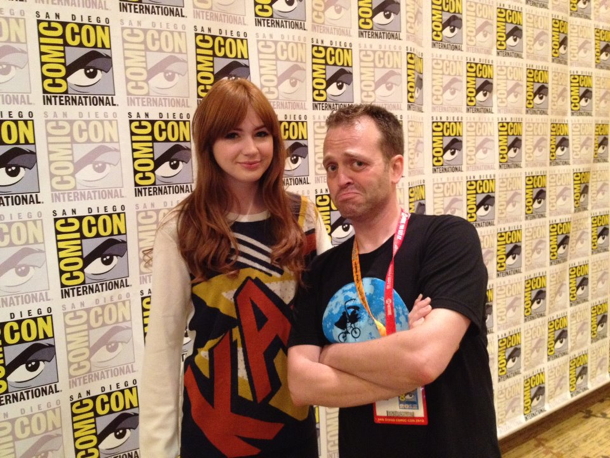HOLLYWOOD HYPERSPACE Being A Doctor Who Fan In America
A lifelong Doctor Who fan, our LA correspondent Joe McCabe's latest Hollywood Hyperspace column explains what the TARDIS looked like from the other side of the Atlantic.


As a US citizen, it’s difficult for me to describe what I love about Doctor Who without describing what I love about the UK in general. But I think I can boil it down to one analogy. A comparison, if you will, between America’s leading science fiction TV franchise and the UK’s. For you see, one could explore the universe wearing a uniform whilst standing on the bridge of a gigantic starship, a crew full of experts and the full firepower of an intergalactic navy at one’s fingertips. But wouldn’t it be just a bit more fun to do it in a stylish suit of one’s own choosing, in a little wooden phone box, with wits sharpened by adventures stretching back a millennium
Like almost everyone, my earliest memories of the world’s most famous Time Lord involve hiding behind a sofa. I’d be eating a bowl of cereal, my parents would have just finished watching a program on PBS (the Public Broadcasting Service, on which Who first aired in the States), and… that music would begin. At once piercing and rumbling, electronic, otherworldly. A wave smashing through the dull murmur of ‘70s suburbia. Our sofa stood against a wood-panelled wall in the family room. So I didn’t really hide behind it so much as next to it – peeking over one arm to see a huge eerily calm face, crowned in curls appearing out of a cosmic void. At six or seven, my mind wasn’t quite ready for it.
Flash forward a few years, however, somewhere into the mid ’80s, and I’m a sci-fi omnivore on the verge of wrapping up grammar school, in love with Star Trek , Ray Bradbury, and any sci-fi film my parents would allow me to rent from the local video store. In an age of Terminators and Predators the viewing choices were limited, but suddenly there again was Who .
They say you never forget your first Doctor. But I had the great misfortune to start with the much-maligned Sixth (played by Colin Baker) in “The Twin Dilemma”, widely considered The Worst Doctor Who Story of All Time. (An impressive achievement, since Whovians rarely agree on anything.) But I didn’t care. So strong was the show’s premise that even its offal could captivate a kid.
The Sixth Doctor’s run was interrupted midway through by an infamous hiatus, giving US stations an opportunity to broadcast the show’s older episodes. It was then that I was able to watch weekly an unbroken string of solid stories from the golden years – most of Jon Pertwee’s episodes, the Third Doctor’s adventures. They offered James Bond’s gadgetry, G.I. Joe ’s military strike force in UNIT, and the kinds of villains and monsters I’d only previously found in comic books. I was hooked.
Throughout the Pertwee repeats I researched the show (Target Books’ What’s What And Who’s Who was invaluable), and heard friends mention the Fourth Doctor. So I was fully primed when Philadelphia’s Channel 12 debuted “Robot” – broadcast, as most serialised Doctor Who stories were in those days in America, as a complete feature film. The floating face was no longer frightening; and like many a teen geek, I found a kindred spirit and the ultimate champion of nonconformity in the bohemian figure of Tom Baker.
Weekly digests, tales from the communities you love, and more
SFX Magazine is the world's number one sci-fi, fantasy, and horror magazine published by Future PLC. Established in 1995, SFX Magazine prides itself on writing for its fans, welcoming geeks, collectors, and aficionados into its readership for over 25 years. Covering films, TV shows, books, comics, games, merch, and more, SFX Magazine is published every month. If you love it, chances are we do too and you'll find it in SFX.


